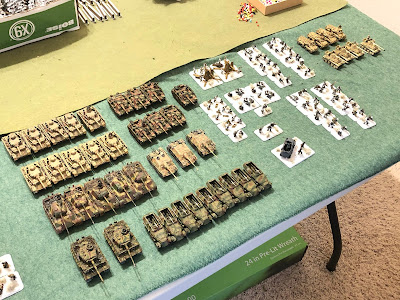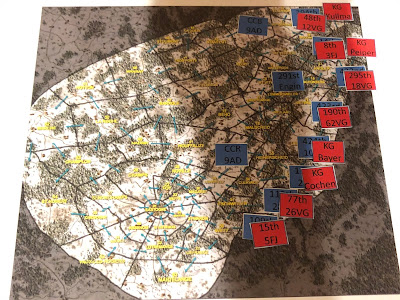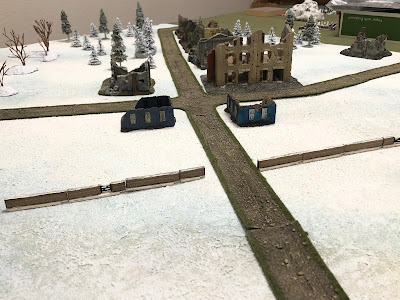All,
First, my apologies for the lack of blogging over the past six months or so. I haven't had much time for wargaming, and what time I have had has been spent painting, but I'm ready to kick off (another overly) ambitious campaign. 2021 was supposed to be the year of the Western Desert, but... I couldn't leave well enough alone. The forces I'd completed for the Western Desert weren't suitable for the early part of the war in North Africa, so I went and bought a bunch more stuff. Work continues on getting it all table ready and, of course, my wargaming butterfly got out and convinced me to try and run about five more projects simultaneously.
I'm happy to report that I've actually finished one, and I'm ready to back into gaming with both foot. Or, hopefully, six feet: mine plus those of my two boys. And where are we going? A massive campaign to play out the bulk of the "Battle of the Bulge," in 15mm. It's not perfect, but here's a look at the forces and my plan.

The whole mess, with Yanks on the left and Germans on the right. You can see a bunch of winter terrain above them. And it's quite a mess; the vast majority is from Battlefront, with some Plastic Soldier Company vehicles and a couple Old Glory guns and crew thrown in. The keen-eyed will notice that none of the vehicles are 'white-washed'/painted in winter colors; sorry, I want to be able to use these for Northwest Europe as well, and there's no way I'm doing all these vehicles twice. I'm already way too far into 15mm WWII, just wait and see (for the posts about other 15mm WWII projects I've been working on)! And here I'll admit, all of this is not my work. I did my fair share of cleaning, building, painting, and basing, but I also bought quite a bit of this force online. Some of it was bought off Ebay or the TMP Marketplace from fellow wargamers, about half the infantry came from Gajo Minis, and quite a few of the vehicles came from AJ Rice, a professional painter. Both Gajo and AJ are fantastic to deal with; nice cost, very responsive, great looking minis, and packed well to make sure no damage.

The US force, consisting of:
12 M4 Shermans
4 M10 Wolverines
3 M7 Priests (I really, really need some M-8 Scott GMCs)
5 M5 Stuarts (these are actually M-3s)
A Recon Platoon of two M20 utility cars and two Jeeps
10 M3 Halftracks
4 rifle platoons (Platoon Commander, Bazooka Team, and three rifle squads)
1 MG Platoon (Platoon Commander and four M1917 machine guns)
1 Mortar Platoon (Platoon Commander and three 60mm tubes)
1 Anti-Tank Gun Platoon (two 57mm guns, need a Platoon Commander)
1 Rifle Company command stand (just a regular infantry stand with three figures on it)
1 Battalion command stand (a couple command figures and two jeeps)
The Shermans.
Wolverines, Priests, Stuarts, and the Recon Platoon.
The US halftracks.
The US infantry.
A closeup of some Shermans.
US recon.
The Stuarts.
The Priests. These and the M3 Stuarts are destined for Tunisia at some point...
The Wolverines, AKA M10 Gun Motor Carriages.
A look at the halftracks. I love them having all the dudes in there. The decals about drove me insane, though, and don't look as good as I'd hoped.
The battalion command stand. The Colonel wasn't sure where to point until he looked over his shoulder and checked with his Sergeant Major...
A look at some rifle stands.
The 60mm mortars.
The machine gun teams.
And the US ATGs.
The German force, consisting of:
10 Panzer Mk IVs
5 Panthers
2 Tiger Is
7 Stug IIIs
3 PzJgr IVs
9 Sdkfz 251 Halftracks
4 Rifle Platoons (Platoon Commander, Panzerschreck Team, and three rifle squads)
1 MG Platoon (Platoon Commander and four MG-42s)
1 Mortar Platoon (Platoon commander and three 8.0cm tubes)
1 Anti-Tank gun Platoon (2 88mm PaK-36 guns, need a Platoon Commander)
And then it (I?) gets a little silly. There is a platoon of Sdkfz 231 armored cars and Marder III tank hunters; I don't have any of these for NW Europe, so I... borrowed them from my Afrika Korps forces...
The Panzer IVs.
The Panthers.
The Tigers.
The Stugs.
The PzJgr IVs, with long 75s.
The German halftracks. I really need to get some Sdkfz 250s as well...
The German infantry.
The Marder and Sdkfz 231 platoons from my Afrika Korps forces. The boys and I are scheduled to play tomorrow morning, so tonight I'm going to paint the yellow helmets gray, and put some decals on the Marders.
Some closeups of the Panzer IVs.
And Panthers.
Tigers. I had more but sold them, for some reason only keeping two...
German halftracks.
The Panzerjaeger IVs.
The Stugs.
The German battaloin command stand.
The German 88s.
Some German riflemen.
The German machine guns.
The German mortars.
The armored cars. Yeah, just ignore the Afrika Korps decals...
The Marders.
Now, for my plan! This might seem funny, but long before I ever got into miniature wargaming I played wargames on the computer, and my favorite computer wargame(s) was "Close Combat," particularly the 2nd one, "A Bridge Too Far," which is definitely on the docket for stuff to game. In any case, I also had the 4th Close Combat module, "Battle of the Bulge." It doesn't cover the entirety of Wacht Am Rhein, but a good portion of it, and it has an outstanding campaign map and details all the units, their composition, their locations, and the reinforcement schedule.
So why not use it? Here is the campaign map I grabbed from Close Combat 4.
Here are the unit rosters I made up (US on left and German on right) using the game's battle editor.
The campaign will start at 0600 on 16 December 1944. I made up counters in Powerpoint, printed them off, cut'em out, and now the US forces are in place for the German onslaught. The Yanks begin with 11 of their 27 battlegroups on the board. Strangely enough, both sides have a total of 27 battlegroups. "Battlegroup" is a general term for roughly regimental-sized combat teams, which will field a roughly battalion-sized force during each tabletop battle it's involved in.
So we'll move these counters around on the campaign map, and when opposing forces land on the same map sector we will fight a tabletop battle of approximately battalion vs battalion. Battlegroups will suffer casualties in each of their tabletop battles, and so each battlegroup will be able to fight between 1 and 6 tabletop battles, depending on the results of each battle. I'll be rating each battlegroup's tabletop performance along the lines of Breakthrough-Major Victory-Minor Victory-Stalemate-Minor Defeat-Major Defeat-Route, which will directly impact how long the battlegroup can stay in the campaign. I'm thinking something along the lines of each Battlegroup having six 'strength points," losing them as follows:
Breakthrough -1 or 0
Major Victory -2 or -1
Minor Victory -3 or -2
Stalemate -4 or -3
Minor Defeat -5 or -4
Major Defeat -6 or -5
Route -7 or -6
I like the latter, except I don't really love the idea of a 'Breakthrough' victory costing the battlegroup no strength points, meaning they could just rampaging on forever. Having said that, I can't imagine 'Breakthrough' victories will happen all that often. But something going for the initial stats is it will speed the campaign up, which I'm really going to need. If every battlegroup fights two battles, well, that's a lot of battles ;)
Here is the reinforcement schedule. Yeah, kinda goofy, but it works. Starting at left is Day 1, then moving right all the way through Day 10, 25 December 1944.
And here is the Day 1, Phase 1 positions for the Yanks and the Germans. There are eight 'overlaps,' meaning there will be eight tabletop battles. So the campaign will have 10 days, each with three phases: Phase 1 is 0600 to 1400, Phase 2 is 1400 to 2200, and Phase 3 is 2200 to 0600. Reinforcements will arrive in Phase 1 of the day they are scheduled.
When a battlegroup is defeated on the tabletop it will fall back two map sectors. Foot-borne battlegroups move one map sector and mechanized battlegroups move two map sectors during normal map movement.
Here is the full slate of battles for Phase of 16 Dec 44:
Krinkelt-Rocherath: 394th Regiment, 99th Infantry Division vs 48th Regiment, 12th Volksgrenadier Division
Losheim: 14th Cavalry Group vs 8th Regiment, 3rd Fallschirmjager Division
South Eifel: 422nd Regiment, 106th Infantry Division vs 295th Regiment, 18th Volksgrenadier Division
Habscheid: 423rd Regiment, 106th Infantry Division vs 190th Regiment, 62nd Volksgrenadier Division
Leidenborn: 424th Regiment, 106th Infantry Division vs Kampfgruppe Bayer, 116th Panzer Division
Dasburg: 112th Regiment, 28th Infantry Division vs Kampfgruppe Cochenhausen, 2nd Panzer Division
Hosingen: 110th Regiment, 28th Infantry Division vs 77th Regiment, 26th Volksgrenadier Division
Weiler: 109th Regiment, 28th Infantry Division vs 15th Regiment, 5th Fallschirmjager Division
And for the first battle we have chosen Losheim, a duel between the U.S. 14th Cavalry Group and the German 8th Regiment, 3rd Fallschirmjager Division.

My winter table, a humble stab at Losheim. North is up, the Germans will attack from the east (right) and the Americans are defending in the west (left). It's funny, I may have picked the only map in the whole campaign that is flat! And the one thing this photo shows me is, you can never have enough trees...
A closer look at Losheim. I really want to bring out the war-torn ambience for the boys, so I'm using nothing but bombed out buildings.
The crossroads. Yeah, I put a lot of work into making a winter table, except roads...
Looking west down the main road, towards Losheim.
The German end of the table.
And the American end. My map actually didn't show a hill, but the table was just too damn flat, so I had to add one (bottom left). At center left are three sets of winter-stripped trees; what the map shows is a series of snow drifts, like seven or eight of them.
Looking northwest to southeast.
The opposing forces, with the American 14th Cavalry Group on the left and the German 8th Regiment, 3rd FJ Division, on the right. The Germans actually shouldn't have any vehicles in this fight, but you'll have to forgive me, I wanted to give the boys a relatively even-up fight, so there they are. The Germans, being the attackers, do have a quantitative advantage, nonetheless.
The American force:
Battalion Commander
Rifle Company Commander, with Halftrack
2 x Rifle Platoon, with Halftracks
1 x Tank Platoon (5 x M4 Stuarts)
1 x Cannon Platoon (3 x M7 Priests)
The German force:
Battalion Commander
Rifle Company Commander
3 x Rifle Platoons
1 x Mortar Platoon (3 x 8.0cm tubes)
1 x Armored Car Platoon (4 x Sdkfz 234)
1 x Panzerjaeger Platoon (4 x Marder III)
Just a reminder, I post pics of my completed minis and the odd batrep here, but I have a dedicated blog for WWII in the European/Mediterranean theaters, so all the battles of this campaign will be posted to my "Little Lead Crusade in Europe" blog, located here:
Little Lead Crusade in Europe (hakunamatatawars.blogspot.com)So, there it is, new forces and another campaign, let me know whatcha think. The stage is set, everything is set and ready to go, the boys and I kick this off first thing in the morning!
V/R,
Jack





















































